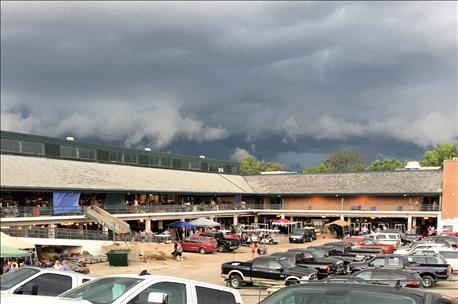
Here’s what I know today: if ever there were a group of people on this planet who know how to get stuff done, it’s the people in agriculture.
Say there’s water pouring through broken gutters and flooding your state fair stalls, farmers will pull out the duct tape and fix it. Ankle-deep water running through the barn? Set all the farm kids to building levees with mulch. No power? Hook up a generator.
And if, given years to get it done, the Illinois General Assembly still won’t pass a bill to create a fairgrounds foundation that could collect free money to fix all this? Well. You do it yourself.

Check out those clouds. And those shingles. This was immediately prior to the storm that dropped 5.1 inches of rain in 2 hours. Generators and power lines in this area were all under water, and some of those golf carts were even floating.
With Gov. Bruce Rauner at his side, John Slayton told the Illinois State Fair Ag Day Breakfast crowd how a group of private citizens had formed the Illinois Fairgrounds Foundation. Slayton, a US Bank vice president and long-time coordinator of the Sale of Champions, says the foundation is the culmination of more than two years’ worth of conversations and work. Talks began with Sen. Bill Brady, who sponsored the first (failed) foundation bill. Philip Nelson was 110% behind it during his tenure as ag director as well, and he and current Director Raymond Poe both made the need clear to Rauner. They lobbied representatives and yet for two years, the House failed to even call the bill for a vote.
“I think the Governor finally got tired of the legislative holdups and went this route,” Slayton says. “I don’t know why the House couldn’t pass it. A foundation makes all the sense in the world. It’s 100% positive.”
I could not agree more. And I appreciate the end run.
As with anything new, however, questions abound. So we took a handful from Prairie Farmer readers and presented them to Slayton. Here’s what he had to say:
When can the foundation start receiving money?
“We’re already getting unsolicited calls from around the state, and that’s a very good sign. State Farm included. But getting a tax ID number is at least a 6-month process. Then the 501(c)3 will be approved and ready to take tax-exempt donations.”
Will funds and projects be subject to procurement code?
“We’re still waiting on a ruling on that.”
Why not take this route sooner?
“Rauner’s been in office less than 2 years. He gave it a run legislatively, and that didn’t work. I think the foundation happened very quickly once it was decided to go this route.”
Where can we write the check for dynamite to blow down the junior barn?
(Slayton laughs.) Editor’s note: I wish there were naming rights for this. I’d pay to light the fuse.
What did the flood do for your cause?
“The wheels were in motion before that, but they are fortunate no one was killed or injured that evening.”
How do we know politicians won’t take the money for something else?
“It’s a private foundation and a separate account; no state of Illinois employee will be able to gain access to it. Foundation officers will write all checks and disburse all money.”
What does the Capital Development Board have to do with it?
“I hope they will play a big role in this, helping us identify projects that are most important, and doing the architecture and engineering studies. Nobody on the foundation board could analyze architectural drawings or engineering studies.”
How will this foundation compare to Iowa’s?
“I don’t know whether theirs was legislative or not. I just know John Deere has thrown a ton of money at it.”
Will the foundation control the financial side of the state fair: entry fees, staff, contracts, judges, etc.?
“It will have nothing to do with that. That will remain under IDOA and the state fair manager.”
Was this circumventing the General Assembly?
“They were given the opportunity to approve it legislatively, so I’m not sure it was done to circumvent them. It was done to get the process going and get the 501(c)(3) going. It’s frustrating to wait for the legislature and they don’t do something that seems like a slam dunk.”
Will the foundation be able to work as seamlessly with the IDOA/State Fair as they would have if the foundation were formed through the legislature?
“Absolutely. The director of ag and the director of historic preservation have a seat and neither have a vote. They can provide input but not a vote. That’s where I think the seamlessness will be, because it's a group of private citizens with a love of the Illinois State Fair that will make all decisions regarding the improvements to the fairgrounds, in both Springfield and Du Quoin.”
Many thanks to Slayton for sharing more information, and to the individuals who made this happen despite deadlock in our state.
Is our government a failure? I’m not sure I’m ready to go that far, but I certainly suspect we’ll see more private efforts like this in the future - if we want to get anything done.
About the Author(s)
You May Also Like






